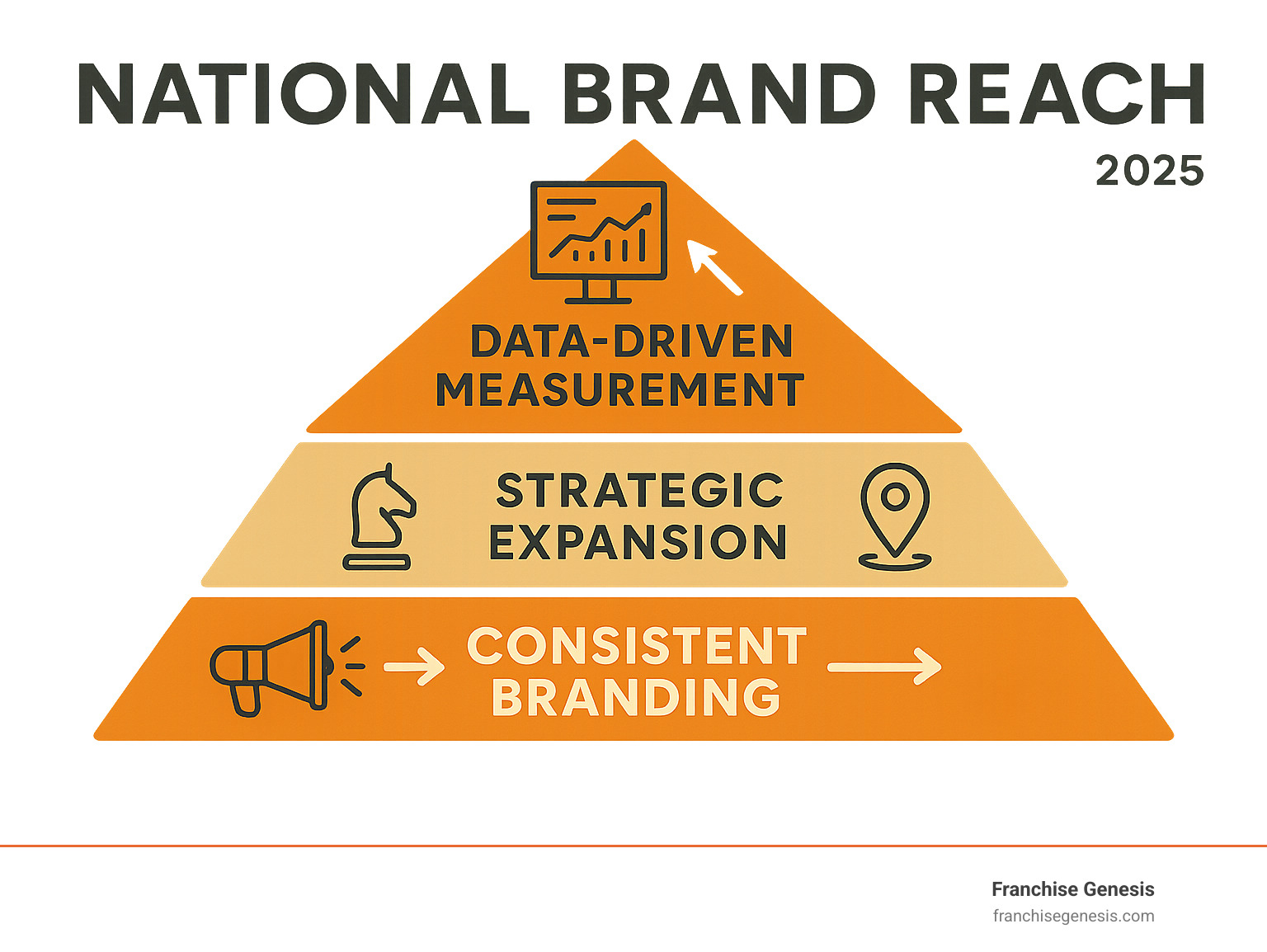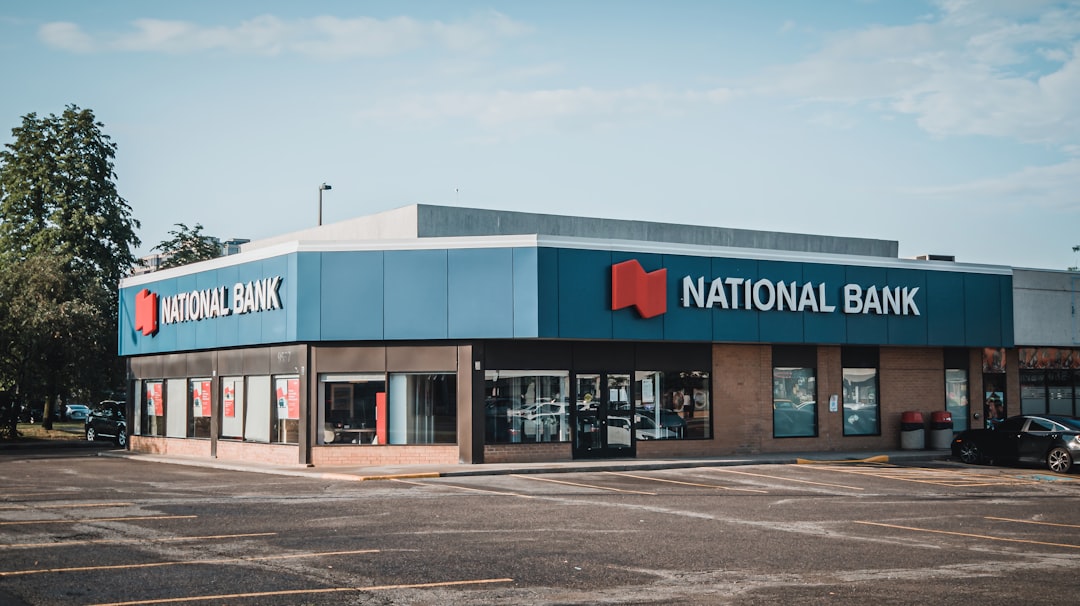Why National Brand Reach is Your Key to Sustainable Business Growth
National brand reach is a brand’s ability to connect with customers across an entire country, creating the widespread recognition and loyalty that drive long-term success. Achieving this reach requires a strategic blend of consistent messaging, smart expansion, and local market adaptation.
Key Elements of National Brand Reach:
- Brand Recognition: Customers know and trust your brand nationwide.
- Widespread Distribution: Your products or services are available across multiple markets.
- Consistent Experience: Quality and messaging remain uniform regardless of location.
- Local Relevance: You adapt to regional preferences while maintaining brand identity.
- Measurable Growth: You track household penetration and market share expansion.
The journey from local favorite to household name is about building a brand that resonates with diverse audiences while maintaining its core values. As Charlie Chappell from Hershey noted at the ANA 2019 Media Conference, successful brands must balance precision with reach, understanding that “if you’re not reaching enough people to deliver your business, you’re going to have a problem.”
For business owners considering expansion, franchising makes national brand reach critical. The franchise model offers a proven path to scale quickly while leveraging local franchisee knowledge. Companies like REESE’S have achieved remarkable success with 94% household penetration, demonstrating the power of strategic national expansion.
I’m Monique Pelle Kunkle, Vice President of Operations at Franchise Genesis. I’ve helped scale businesses to national brand reach through strategic franchising, including guiding an ABA therapy franchise in Hawaii to over 100 locations in its first year. My experience shows that successful national brands master the art of staying consistent while adapting locally.

National brand reach basics:
What is a National Brand? (And Why It Matters for Growth)
Picture the brands you recognize in any store, from Seattle to Miami. These are national brands—products or services with a consistent presence and recognition across the country under one unified identity.
A national brand is more than widespread distribution; it’s a business that has scaled its brand promise, maintaining the same quality and experience everywhere. This consistency builds invaluable customer loyalty that transcends geographic boundaries. When customers trust your brand nationwide, you’re offering familiarity and reliability. This trust translates directly into brand equity, the invisible asset that makes your business more valuable.
For business owners considering expansion, understanding the difference between national brands and private labels is crucial:
| Feature | National Brand | Private Label |
|---|---|---|
| Ownership | Owned by manufacturer, distributed nationwide | Owned by retailer, made by third party |
| Recognition | High, established across markets | Limited to specific retailer |
| Customer Trust | Built through consistent national experience | Tied to retailer’s reputation |
| Expansion Potential | Unlimited geographic reach | Restricted to retailer’s locations |
Household penetration goals tell a compelling story. According to Bain & Company research, brands typically need 10-15% household penetration to achieve meaningful scale. Established brands often maintain 25-30% penetration, while giants like REESE’S boast an astounding 94%.
This level of reach makes national brands incredibly attractive to investors. A brand that consistently touches millions of households has a stable foundation for sustained growth.
Defining Your Brand on a National Scale
Achieving national brand reach creates powerful, compounding advantages. Brand recognition becomes your most valuable marketing asset, dramatically reducing long-term marketing costs because you’re building on existing awareness.
The high revenue potential of national brands stems from this widespread recognition. When customers trust your brand across markets, they are more likely to choose you over local competitors. This consumer trust becomes a protective moat around your business.
As SendPulse explains, national brands deliver “brand recognition, customer loyalty, and high revenue” because consumers gravitate toward familiar, proven options. Your brand becomes part of customers’ daily habits.
The Goal: Achieving Significant Household Penetration
Market saturation is about becoming indispensable. The metric that matters most is household penetration: the percentage of households that purchase your brand within a year.
Think of it as your brand’s report card. 10-15% penetration is the minimum threshold for sustainable scale. At this level, you have enough market presence to justify continued investment. Solid brands typically maintain 25-30% penetration, showing they are preferred choices.
The true champions achieve 50%+ penetration, joining the ranks of perennial brands woven into the fabric of daily life.
Hershey’s media strategy insights emphasize that successful brands must balance precision with reach. You need enough scale to support your business goals while maintaining a distinctive message. For business owners ready to scale, this is why you should franchise—it’s one of the most effective paths to nationwide presence.
Core Strategies for Achieving Widespread National Brand Reach

Building national brand reach requires a harmonized strategy. For business owners ready to scale a successful concept, these core strategies are your roadmap to nationwide recognition and growth.
The Power of Franchising for Rapid Expansion
Franchising offers the most efficient path to take your business national. It’s not just about opening more locations; it’s about scaling a proven business model.
Franchising is powerful for achieving national brand reach because you leverage other people’s investment and local market knowledge. Instead of draining your capital, you partner with passionate entrepreneurs invested in making their local market succeed.
This approach creates faster market entry than you could achieve alone. While you might open a few company-owned locations per year, franchising can help you establish dozens simultaneously across different markets.
The beauty of franchising lies in system-wide marketing commitments. Every franchisee contributes to a marketing fund that amplifies your brand message across all locations. This collective approach transforms a local business into a household name. You can dive deeper into these concepts in our guide on Franchise Growth Strategies and explore opportunities in Franchise Opportunities in All Industries.
Dominating the Digital Landscape
Your digital presence is the foundation of modern national brand reach. It’s how customers find, connect with, and choose you.
Local and national SEO work together to capture customers. While building national authority, each location must dominate local search. This means optimizing listings on Google Business Profile and ensuring consistent information online.
Social media engagement turns customers into brand advocates. Successful national brands tell an overarching story while empowering local franchisees to engage with their communities. User-generated content is pure gold, as customer photos and reviews extend your brand’s reach organically and authentically.
PPC advertising provides immediate visibility in new markets, with broad campaigns for national awareness and hyper-local ads for specific locations. Modern direct mail can reach 100% of households in targeted areas, and adding QR codes bridges the gap between offline and online engagement. Learn more about maximizing these opportunities in our Franchise Lead Generation guide.
Leveraging Partnerships and Influencer Marketing
Strategic partnerships and influencer marketing can catapult your national brand reach by connecting you with new audiences.
The secret is authentic endorsements. Consumers can spot a fake endorsement instantly. Magic happens when you partner with influencers who genuinely use and love your product. Aligning with shared brand values makes partnerships feel natural. When an influencer’s brand matches your company values, their audience is more likely to trust their recommendation.
These partnerships amplify your brand message, introducing your business to new demographics. Experiential marketing takes this further by creating memorable, hands-on experiences like pop-up events or sponsored community activities. This approach is highlighted as one of the 5 creative ways to expand marketing reach that forward-thinking brands use.
Combining franchising with digital dominance and strategic partnerships creates a comprehensive approach to achieving the national brand reach that turns local businesses into household names.
The “Glocal” Approach: Balancing National Consistency with Local Nuance

Imagine your favorite coffee shop having the same quality in Miami and Seattle, but the Miami location offers a special Cuban cortadito and sponsors the local high school. That’s the magic of the “glocal” strategy.
When building national brand reach, you must balance consistency and adaptability. Too much consistency can feel disconnected, while too much local variation can dilute the brand recognition that builds trust. The secret is giving customers the best of both worlds: reliability and a sense of local belonging.
Establishing a Rock-Solid Brand Foundation
Before adapting locally, you must define what never changes about your brand. These are your non-negotiables.
Your comprehensive brand guide is your North Star. It’s a detailed roadmap covering everything from your logo colors to how your team answers the phone. When a customer enters any location, they should immediately recognize your brand.
Consistent messaging forms the backbone of recognition. Your core story—why you exist and what you promise—must remain the same everywhere. This consistency builds the trust that creates lifelong customers.
For franchise owners, operational standards are critical. Every location must deliver the same quality experience, from the product itself to the service and cleanliness. Maintaining these standards protects quality and builds the foundation for national brand reach.
Centralized technology support ties everything together. When all locations use the same systems for payments and customer tracking, you create seamless experiences and gather valuable data to better serve customers nationwide.
Empowering Local Adaptation for Maximum Impact
Once your foundation is solid, you can adapt to what makes each local market special.
Local promotions and offers let you respond to community needs. A Denver location might offer a “Snow Day Special,” while a Phoenix spot creates a “Beat the Heat” deal. The promotions differ, but both reflect your brand’s commitment to customers.
Community event sponsorship transforms you into a genuine community partner. Sponsoring a local Little League team or a town festival shows you’re invested in the place your customers call home, creating powerful emotional connections.
Cultural adaptation means respecting the unique preferences of each market. A taco shop in San Antonio might offer different spice levels than one in Minneapolis because it understands its customers’ tastes.
Hyper-local social media engagement provides a direct line to your community. While national accounts tell your brand story, local pages can celebrate a high school team’s victory or share photos from a charity drive.
Smart local adaptation can also include:
- Tailoring advertisements to local events
- Partnering with beloved local businesses
- Featuring local customers in your marketing
- Creating location-specific web content to improve local search visibility
This balanced approach makes your national brand feel like it belongs everywhere it operates, driving sustainable Franchise Unit Growth.
Measuring What Matters: Data, Technology, and Key Metrics

Building national brand reach without data is like navigating without a map. You need clear reference points to know if you’re heading in the right direction. Successful companies focus on metrics that directly tie to business growth, not vanity numbers that look impressive but don’t drive results.
Understanding Your KPIs for National Brand Reach
Every business owner should understand these fundamental metrics for measuring brand reach.
Reach versus impressions is a commonly misunderstood concept. Reach is the number of unique people who see your content, while impressions is the total number of times your content is displayed. One person might see an ad five times (five impressions), but they only count as one person reached. You can find detailed metric definitions online, but what matters is that reach measures the breadth of your influence.
Engagement rate measures whether people care enough to interact (like, share, comment). High engagement suggests your message resonates, which is vital for building trust across diverse markets.
Conversion tracking is where the rubber meets the road. It tracks whether people are taking desired actions, like visiting your website or filling out a form. This is critical for franchise businesses, where a conversion could be a new franchisee or customer.
Brand lift measures how your campaigns change public perception of your brand. Are people more likely to recommend you or trust you more? This qualitative impact often determines long-term success.
For businesses with physical locations, location visitation tracking shows if your marketing efforts are driving foot traffic, bridging the gap between digital campaigns and real-world results.
Using Data and Technology for Smarter Targeting
Smart businesses use data to understand who their customers are and how to reach them effectively.
First-party data, which you collect directly from customers, is your secret weapon. It reveals not just who your customers are but also how they behave and what they value.
Modern technology enables hyper-targeting far beyond basic demographics. You can reach people based on their behaviors, interests, and specific neighborhoods. Companies like Comcast Advertising use detailed data to help brands connect with audiences across multiple screens, focusing on measurable business outcomes.
AI and data analytics process massive amounts of information to spot patterns, predict customer behavior, and optimize campaigns in real-time. This ensures your marketing budget works as efficiently as possible.
Personalized customer interactions are possible when you understand your audience deeply. You can create communications that speak to individual needs, building the trust essential for national brand reach.
Successful franchise systems treat data as their navigation system. They know which markets are responding, which messages resonate, and which channels deliver the best ROI. This strategic approach is fundamental to developing strong Franchising Insights that drive sustainable growth.
Overcoming Common Challenges in National Expansion
Every business owner dreams of coast-to-coast recognition, but the path to national brand reach has challenges. These obstacles aren’t roadblocks; they are part of the journey that successful brands learn to steer strategically. Overcoming challenges is what separates the brands that make it from those that don’t.
Maintaining Quality and Consistency at Scale
Brand dilution is a common fear for expanding business owners. As you grow nationally, how do you ensure the same magic that made you a local success happens everywhere? One bad experience in a new market can damage your reputation nationwide.
The solution isn’t rigid control but building robust systems that make consistency feel natural.
Comprehensive franchisee training is your first line of defense. It should be an intensive program that instills your brand’s values and culture, not just its processes. When franchisees understand the why behind your methods, they become passionate brand protectors.
System-wide support ensures no franchisee feels isolated. Ongoing operational guidance, marketing assistance, and tech troubleshooting help maintain standards and build confidence.
Technology integration serves as the backbone of consistency. Centralized systems for inventory, CRM, and performance tracking ensure everyone uses the same playbook while providing data to address issues proactively.
Securing Capital and Resources for Growth
Achieving national brand reach requires significant investment in marketing, infrastructure, and personnel. This financial reality can feel overwhelming.
This is where the franchise model is a game-changer. Instead of shouldering the entire financial burden, you leverage franchisee investment to fuel growth. Your franchisees invest in their own units, reducing your capital requirements while accelerating expansion.
Instead of needing hundreds of thousands to open each new location yourself, qualified franchisees bring that investment to the table. They are investing in their own success, which aligns perfectly with your brand’s growth goals.
Attracting investors becomes easier when you have a strong, proven brand concept. A track record of consistent performance and franchisee success makes your opportunity compelling. Potential franchisees are investing in a proven path to national brand reach.
The franchise model also forces you to optimize operational efficiency. Streamlined supply chains and proven marketing systems don’t just help franchisees—they strengthen your entire brand ecosystem. Understanding how to Transform Leads into Loyal Franchisees with a Proven Sales Strategy is crucial for open uping this growth. The future belongs to brands that can scale intelligently, and franchising offers a proven pathway to steer The Future of Franchising successfully.
Frequently Asked Questions about National Brand Reach
Business owners considering franchising their successful local business often have burning questions about what it takes to build national brand reach. Here are the answers to the questions we hear most often.
What’s the difference between a national brand and a private label?
A national brand is a product or service distributed nationwide under a single brand name that you own. These brands build consistent recognition and customer trust across millions of customers. When you franchise, you are building a national brand.
A private label is different. A retailer (like a grocery store) hires a third party to manufacture products sold under the retailer’s own brand name, like store-brand milk. They are often positioned as cost-effective alternatives, but their reach is limited to that specific retailer’s locations.
How much market penetration does a brand need to be successful?
While every business is different, industry benchmarks can guide your planning.
The typical target for initial scale is 10% to 15% household penetration. This means 10-15% of households in your target market choose your brand annually. At this level, you’ve achieved the scale needed to sustain a franchise system.
Solid, established brands often maintain 25% to 30% penetration. These brands have become trusted fixtures in their markets and can better weather economic shifts.
The most iconic brands can achieve 50% or even higher penetration. REESE’S, for example, has reached an astounding 94% household penetration. While an outlier, it shows what’s possible when a brand resonates with consumers nationwide. For franchisees, higher penetration means more consistent revenue and greater resilience.
How can a national brand stay relevant in local markets?
This is where the franchise model shines. The answer is a “glocal” strategy: maintaining your core brand identity while empowering local adaptation.
Your brand’s foundation—core values, quality standards, and messaging—must remain consistent everywhere. This consistency builds the trust that defines a national brand.
At the same time, successful national brands empower smart local adaptation. Your franchisees are your secret weapon, as they understand their local markets better than any corporate team. They know which community events matter and how to connect authentically with their neighbors.
This could mean running community-specific promotions, sponsoring a local sports team, or adapting service offerings to regional tastes. Local social media engagement is another powerful tool for building neighborhood relationships that turn customers into advocates.
The key is to create systems that encourage local relevance while protecting brand integrity. This balance allows you to build true national brand reach while maintaining the community connections that made you successful.
Conclusion
Building national brand reach is about crafting a story that resonates from coast to coast while staying true to your business’s core. The right blend of consistency and local adaptation can transform a beloved local business into a household name that customers trust everywhere.
The franchise model is one of the most powerful tools for this change. By franchising, you empower passionate entrepreneurs who bring local knowledge and investment to your proven concept, creating a win-win for rapid, sustainable growth.
Digital dominance is non-negotiable. A strong online presence, from local SEO to authentic social media engagement, must match your physical footprint. The “glocal” approach ensures you can be everywhere while belonging somewhere, maintaining a rock-solid brand identity while allowing for the local flexibility that builds deep customer connections.
Data and measurement keep your strategy on track. Understanding your KPIs, from reach to household penetration, allows you to make smart, data-driven decisions.
Challenges like maintaining quality and securing capital are real, but they are manageable. With robust training systems and the franchise model’s capital-efficient structure, these problems become stepping stones to success.
At Franchise Genesis, we’ve walked this path with countless businesses, helping them scale from single locations to national brand reach. We understand the vision and courage it takes. Our role is to be your trusted partner, providing the expertise and support to turn that vision into a reality.
Your business has already proven it can succeed. Imagine that success multiplied across the country. Ready to explore what that looks like for your business? Find out how to Franchise Your Business with us as your guide.
